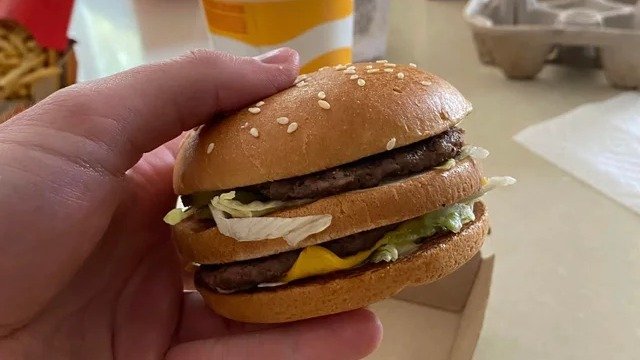Everyone knows what it feels like to be duped or tricked . Hollywood does it to us all the time , and now some of our favorite brands are doing the same.
When brands do it, there’s actually a term for the phenomenon: shrinkflation . Due to a combination of factors, including material costs and a brand’s desire to make bigger and bigger profits , consumers often wind up paying more money for less product .
What can we as consumers do about it? Honestly, looking at this list of extreme examples of shrinkflation might be all we can do.
“Wood flooring, now with less hardwood!”

You know how old houses often have beautiful hardwood lurking underneath the carpets? I wonder what it’ll be like in a few decades when lots of houses have hardwood that’s about a third of an inch deep.
“New take on shrinkflation: exact same product miraculously ‘65% more.'”

This is the laziest kind of shrinkflation. They’re not taking product out of the package, which is good, but they are printing up new packaging to try and convince consumers that the same product is suddenly an incredible deal.
“I knew something was fishy when I bought my creamer yesterday.”

Here’s another common tactic with shrinkflation: significantly reducing the amount of product inside a container, but designing the new container in such a way that it doesn’t really look any smaller than the old, bigger one.
“The slices of this chocolate orange have hollows now.”

It’s been a minute since I had a chocolate orange, but I certainly don’t remember them being like this. In fact, I remember them being a gloriously dense sphere of chocolate. What happened, Terry’s?
“Monster coming in with some scary 25% shrinkflation. Shrink so hard, they had to change the entire packaging for the size of the new can at the same price.”

Taking a quarter of the product away is a significant reduction, but once again, both containers look almost identical at first blush. The only giveaway is that the smaller can is slightly narrower.
“Seen this while stocking cookies.”

Maybe these two boxes of cookies are intended for markets, markets where families come in far different sizes? That’s the only thing that I can think of, because they’re drastically different sizes, yet both labelled ‘family size.’
“2 Twix short of a yard.”

I didn’t know that you could buy a full yard of Twix bars. I love the idea. But after seeing this treachery, it’s going to be hard to trust Twix ever again. Why couldn’t they just throw in two extra bars?
“Same price. Bought the last one 3 weeks ago, and a new one today for Thanksgiving.”

This is a common experience, particularly if you have a go-to brand: buying the same thing, sensing that something is different, but not being totally sure.
“NuGo bars advertised as 50g but coming in at 41g.”

I’m not sure if this even qualified as ‘shrinkflation.’ Honestly, it feels more like ‘lying.’ That bar is a full 9 grams short of what’s claimed, and that’s including the weight of the packaging.
“$0.99 for the top one last year. Just bought the bottom one for $1.97.”

This is probably the most common form of shrinkflation you’ll see: a product that’s taken out just a little bit, so little you probably won’t notice, but charging the same or more than before.
“Plenty of room to spare.”

One of the infuriating aspects of shrinkflation is that products are often put in oversized containers to increase the perception that they’re good value. This is just cardboard, which is pretty eco-friendly, but not all packages are like this.
“Yes, this is new and unused.”

Here’s an example of the same thing, only in this case, that plastic bottle is decidedly less eco-friendly. Sometimes, products say “settling may occur during transit” as a way to excuse themselves for having so little product in such a large package.
“Pack of gum.”

It might seem chintzy for a gum company not to throw in one extra piece of gum, and it is. But multiply this package of gum by a few million, and you can see how the savings mount up for the gum company.
“Oreo shipped with three cookies face down.”

This is kind of like the Twix example a few items back. It’s like Oreo dutifully filled the package most of the way, then balked at including a few extra Oreos and just kind of faked their way through the rest of the process.
“Oreo filling isn’t just thinner. Now it doesn’t even reach the edge.”

Oreo, are you really going to do this? Yes, fillings have gotten smaller — just look at how little filling is now included in a Double Stuf Oreo.
“These used to be 6 to a pack. Same price of course.”

There’s something about getting five of something when you’re used to getting six that’s deeply unsatisfying. I mean, imagine how weird it would feel to buy a five-pack of beer.
“The top box is from a well established reoccurring promotion.”

This brand of tea is well known for its ‘extra 50% free’ boxes of tea. Now it’s preying on consumers with a deliberately misleading ad on its boxes, done up in the same style.
“Breyers Chocolate Chip used to be jammed with chocolate, now it’s almost just plain vanilla.”

The good news here is that you’ll get a full tub of ice cream. The bad news, of course, is that it’s all ice cream and no chocolate chips.
“This must be their way of saying ‘We decreased the amount but kept the container size the same.'”

I don’t know if I hate the company for trying to justify its shrinkflation, or if I appreciate the attempt to explain things.
“Big Mac hit with the shrink ray?”

This is absolutely ludicrous. McDonald’s claims that they haven’t shrunk the size of their iconic sandwich , but this pic would seem to suggest otherwise. Maybe the person holding is just has giant hands.

















































